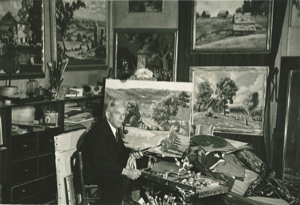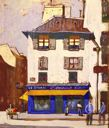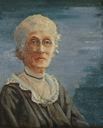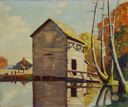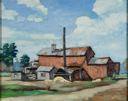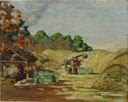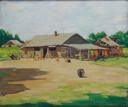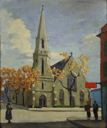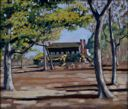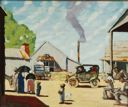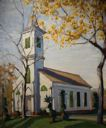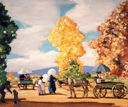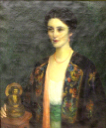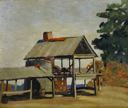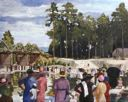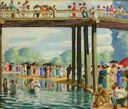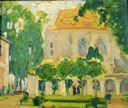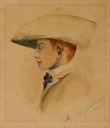John Kelly Fitzpatrick
American
(Wetumpka, Alabama, 1888 - 1953, Wetumpka, AL)
John Kelly Fitzpatrick was born on August 15, 1888 in Wetumpka, Alabama. Fitzpatrick’s family originated in Virginia and became prominent land owners in central Alabama after 1816. By the time Fitzpatrick was born, his family had a fairly comfortable lifestyle. Fitzpatrick was raised in Wetumpka, lived there most of his life and eventually set up his studio there as well. Fitzpatrick was artistic from an early age. In 1930, he wrote of his earliest painting endeavor at the age of four: “Using paints and brushes left casually by Santa, I painted my first picture. The success of this modernist picture was instantaneous and so great, that I decide painting pictures was the most worthwhile thing to do in life.”(1) Fitzpatrick was educated at Starke University School in Montgomery and in 1908 attended the University of Alabama at Tuscaloosa.
From March to July 1912, Fitzpatrick enrolled in classes at the Art Institute of Chicago. The artist attended basic studio classes, which established a foundation in technique. "Chianti Wine Bottle" (1912, Private Collection) is typical of his student technique. The painting represents an exercise in still-life composition and modeling. While there are novice difficulties with perspective and depth, the work shows that the artist had an easy command over the watercolor medium, which characterized his technique throughout his career. Fitzpatrick used a painterly brushstroke, modeling the objects with cast light and surface reflection to define their contours. Other surviving works from Fitzpatrick’s student days are from his life drawing classes. They demonstrate his competence in handling the basics of anatomical drawing with smooth, flowing lines and shadowing to suggest volume. These life drawings were either created at the Art Institute or at the Academie Julien in Paris, where Fitzpatrick studied in 1926. Apart from these two periods of study, the artist’s style evolved informally through his experiences while traveling and from his eventual reliance on expressive color as the dominant element in his art.
Fitzpatrick’s life was interrupted in 1914 with the beginning of World War I. The artist enlisted in the United States Army in March of 1918 and served with the 12th Machine Gun Battalion in France. Fitzpatrick suffered shrapnel wounds during the Battle of the Meuse-Aragonne on July 19, 1918, which caused permanent scarring in areas of his face, neck, and chest. The horrors of war and his own wounds provided a profound backdrop for his later paintings. His pastoral scenes of rural Alabama marked a sharp counterpoint to the destruction and pain the he experienced. Fitzpatrick later wrote to one of his students that his war experience had deflected an interest in the material aspects of life, which may in turn, have influenced his decision to devote himself to art. “I had been through the furnace of War,” he said, “and I knew that nothing mattered but the Spiritual things of this world…”(2) Throughout his life and art, Fitzpatrick would always maintain the attitude that life was made worthwhile by the pursuit of elusive and tangible beauty.
After the War, Fitzpatrick settled in Wetumpka once again, and devoted himself to teaching, painting, and promoting regional art organizations such as the Montgomery Museum of Fine Arts and the Alabama Fine Arts League. Despite the great personal rewards of supporting these institutions, they never supported the artist financially. Fitzpatrick primarily relied on teaching and commissions from the Depression-era government sponsored programs for artists.
Fitzpatrick also traveled a great deal. His letters and journals show that his travels were a great source of pleasure to him and he responded enthusiastically to the stimulus of new environments and cultures. While in Europe in 1930, he visited France (including a short visit to Monet’s gardens at Giverny), Italy, and the Mediterranean, making sketches in his travel notebooks. Fitzpatrick’s visits had an impact on his work, as his style of the 1930s is characterized by brilliant color and painterly brushwork most closely related to the paintings of early twentieth-century French artist. For example, Fitzpatrick was receptive to Paul Cezanne, Vincent Van Gogh, and Henri Matisse, whose works would have been prominently displayed throughout galleries and museums the artist visited. The Post-Impressionists and Fauves placed specific emphasis on color and light in their paintings, using bold nonnaturalistic color, blocky forms and vigorous brushwork. These styles were adeptly translated into Fitzpatrick’s Alabama landscapes. For example, "Monday Morning" (1934, Montgomery Museum of Fine Arts) is typical in subject, composition, and technique. A harsh, morning sun shines down on a group of black figures arranged in vignettes. The figures have no specifically identifiable facial features, but are types characterized by their dress and occupations. Strong contrasts of color produce the impression of the late morning sun.
Fitzpatrick’s other works consistently display the two dominant features in "Monday Morning"—a combination of a familiar rural scene and the black culture that coexisted with it. Raised in the country, Fitzpatrick was an observer of the black tenant farmer culture with its attendant poverty and modest means of survival. Despite his knowledge of this reality, the monumental, peaceful mood of landscapes bathed in sunshine always extends to the inhabitants as well. The Museum’s "Negro Baptizing" (c.1930-31) is another example in which Fitzpatrick represents a black community witnessing a baptism.
In 1933, President Roosevelt was inaugurated and began his New Deal programs in an effort to relieve the devastation of the Depression. Four different federal art programs offered relief and patronage specifically to artists during the Depression, and Fitzpatrick had at least a passing acquaintance with each of them. All programs associated with the New Deal had relief as a goal, but the four art projects were also formed to foster, nurture, and establish the visual arts as a part of American culture, an adjunct to the New Deal’s American dream.
The initial program was the short-lived PWAP—The Public Works of Art Project. Initiated in December of 1933, the program was funded through the Civil Works Administration and run by the Treasury. Each artist accepted into the PWAP was categorized by the type of work he produced: murals, portraits, historic streets and buildings, or regional industries, the category in which Fitzpatrick was placed. For his work in PWAP, Fitzpatrick received a weekly wage of about $38, for which thirty hours of work was expected. A series of black-and-white photographs of Fitzpatrick’s paintings for the project show twelve works depicting the primitive industries in Alabama. One of these works, The Water Mill, was chosen by President and Mrs. Roosevelt to be hung in the White House, along with thirty-one others.
Another New Deal program was TRAP, The Treasury Relief Art Project, a branch of the WPA that lasted from July 1935 to June, 1938. It placed art in existing federal buildings. For this program, Fitzpatrick produced two murals in Alabama post offices: Ozark and Phenix City. For Ozark, Fitzpatrick painted Ozark, Alabama, a reflective landscape that depicts two lakeside houses. For Phenix City, the artist painted a mural that represented the cotton industry of Alabama. Apart from his involvement with the New Deal programs, Fitzpatrick’s time in the 1930s was also occupied with teaching and his involvement with the Dixie Art Colony in southern Alabama.
By the 1930s, Fitzpatrick had earned a considerable reputation in central Alabama as a painter of landscapes and the local environment, which enhanced his popularity as a teacher. A founder of the Museum in 1930, Fitzpatrick was also a founder of the Alabama Art League and active in the Southern States Art League. He served as the first director of the Montgomery Museum Art School and was the primary teacher there.
As a teacher, Fitzpatrick believed that instruction should interfere as little as possible with the student’s natural inclinations. In a quote from a letter to one of his students, the artist said, “…all criticism must be comparative until the student is ready for the real stuff…EVEN THEN it is no good unless it helps a person to express HIMSELF. IN HIS OWN WAY…no criticism is or can be of any good that isn’t [sic] personal and sympathetic and UNDERSTANDING and that will help that individual person to express himself.”(3)
Fitzpatrick’s most popular teaching method, painting landscape en plein air, was institutionalized in the Dixie Art Colony. The Colony was established in 1933, and eventually housed in several cabins at Lake Jordan. The Colony allowed artists to camp at the lake, take instruction, and make daily excursions to paint in the area. The site they called “Poka Hutchi,” attracted artists of varying levels of skill, from professionals such as Anne Goldthwaite, Georgia’s Lamar Dodd and Frank Applebee of Auburn art faculty, to youngsters from Montgomery and surrounding areas who could learn from this enriched, natural art environment.
Overall, Fitzpatrick and his “school,” were a Southern model which reflected the larger trends in American art of that period. By the 1930s, the most pervasive philosophy guiding American artists was that of the Regionalists. Fitzpatrick’s life history and work were similar to that of Missouri native Thomas Hart Benton. Benton and Fitzpatrick’s work share common figure types, in which the figures are languid and manneristic, lacking individualism. Benton was originally sympathetic to modernism, but rejected European styles to promote what he saw as art that was uniquely American, tied to our shared cultural experiences and rooted in the values of the land. This was a theory that specifically supported Fitzpatrick’s idealized view of the Alabama landscape with its black native culture. Works such as "Negro Baptising," and "Swing Low Sweet Chariot" (1944, Alabama Department of Archives and History) are examples of the influence of Regionalism with its emphasis on the simplicity of rural life and Christian traditions as a positive force in American society.
The second movement, Social Realism, depicted socially and politically relevant themes and is characterized by problems associated with the Great Depression. A small group of southern artists banded together in 1939 to exhibit under the name of the New South School. They focused specifically on black sharecroppers and their families, poor urban blacks and the general plight of the populace in Alabama during the Depression. In contrast, Fitzpatrick rejected art that included social commentary and all forms of what he termed “the cult of the ugly,” meaning modernism. Despite this, it is interesting to note that Fitzpatrick’s stylization essentially derived from French modern movements.
In the 1940s, as a part of the Dixie Art Colony, Fitzpatrick helped to organize small, informal painting trips to Bayou La Batre, a small fishing village west of Mobile on the Portersville Bay area of the Gulf Coast. Their trips recalled great art traditions of nineteenth century artists who sought solitude and subject matter in the quaint villages of the Breton region of France. Fitzpatrick, along with four other artists—Warren LeBron, Louise Everton, Louise Hemenway and Geneneve Southerland—called themselves “The Five Alabamians” and arranged traveling exhibitions of their work which they scheduled for month long shows at galleries in the East and Midwest from November 1945 to September 1946. Painting in a safe, conventional style, Fitzpatrick produced works of local appeal which did not find wide acceptance outside of Alabama. While he understood the art world was more interested in avant garde, he was neither mad nor envious of younger artists who received recognition for their less conservative work. In the 1950s, Fitzpatrick printed a brochure about the Bayou La Batre colony, in an effort to bring more people. Part of the artist’s larger aim was to provide opportunities for training and exhibitions in order to keep southern artists in the South.
Fitzpatrick continued to paint for the rest of his life. The artist had just started a mural commission for the Bank of Tallassee and had recently completed Swing Low, Sweet Chariot when he suffered a heart attack on April 18, 1953.
Kelly Fitzpatrick is perhaps the greatest contributor to the arts in Alabama during the twentieth century. Not unlike Alabama native Clara Weaver Parrish, Fitzpatrick tirelessly championed for the arts, by supporting and founding a number of art organizations and teaching. While his art never reached national recognition along with other Regionalist painters, Alabama will forever be in debted to this great painter.
1) Margaret Lynne Ausfeld and Christine Crafts Neal, A Symphony of Color: The World of Kelly Fitzpatrick, 1888-1953 (Montgomery: Montgomery Museum of Fine Arts, 1991: 12.
2) Ausfeld and Neal, 11. For some European artists World War I affected their art in opposite ways than that of Fitzpatrick. For example, Otto Dix (1891-1969) created paintings that depicted the horrors of war and its affects on the population.
3) Ibid, 19.
- Margaret Lynne Ausfeld and Christine Crafts Neal, 5/9/04
Image credit: Photograph of John Kelly Fitzpatrick in his studio courtesy of the Montgomery Museum of Fine Arts
American
(Wetumpka, Alabama, 1888 - 1953, Wetumpka, AL)
John Kelly Fitzpatrick was born on August 15, 1888 in Wetumpka, Alabama. Fitzpatrick’s family originated in Virginia and became prominent land owners in central Alabama after 1816. By the time Fitzpatrick was born, his family had a fairly comfortable lifestyle. Fitzpatrick was raised in Wetumpka, lived there most of his life and eventually set up his studio there as well. Fitzpatrick was artistic from an early age. In 1930, he wrote of his earliest painting endeavor at the age of four: “Using paints and brushes left casually by Santa, I painted my first picture. The success of this modernist picture was instantaneous and so great, that I decide painting pictures was the most worthwhile thing to do in life.”(1) Fitzpatrick was educated at Starke University School in Montgomery and in 1908 attended the University of Alabama at Tuscaloosa.
From March to July 1912, Fitzpatrick enrolled in classes at the Art Institute of Chicago. The artist attended basic studio classes, which established a foundation in technique. "Chianti Wine Bottle" (1912, Private Collection) is typical of his student technique. The painting represents an exercise in still-life composition and modeling. While there are novice difficulties with perspective and depth, the work shows that the artist had an easy command over the watercolor medium, which characterized his technique throughout his career. Fitzpatrick used a painterly brushstroke, modeling the objects with cast light and surface reflection to define their contours. Other surviving works from Fitzpatrick’s student days are from his life drawing classes. They demonstrate his competence in handling the basics of anatomical drawing with smooth, flowing lines and shadowing to suggest volume. These life drawings were either created at the Art Institute or at the Academie Julien in Paris, where Fitzpatrick studied in 1926. Apart from these two periods of study, the artist’s style evolved informally through his experiences while traveling and from his eventual reliance on expressive color as the dominant element in his art.
Fitzpatrick’s life was interrupted in 1914 with the beginning of World War I. The artist enlisted in the United States Army in March of 1918 and served with the 12th Machine Gun Battalion in France. Fitzpatrick suffered shrapnel wounds during the Battle of the Meuse-Aragonne on July 19, 1918, which caused permanent scarring in areas of his face, neck, and chest. The horrors of war and his own wounds provided a profound backdrop for his later paintings. His pastoral scenes of rural Alabama marked a sharp counterpoint to the destruction and pain the he experienced. Fitzpatrick later wrote to one of his students that his war experience had deflected an interest in the material aspects of life, which may in turn, have influenced his decision to devote himself to art. “I had been through the furnace of War,” he said, “and I knew that nothing mattered but the Spiritual things of this world…”(2) Throughout his life and art, Fitzpatrick would always maintain the attitude that life was made worthwhile by the pursuit of elusive and tangible beauty.
After the War, Fitzpatrick settled in Wetumpka once again, and devoted himself to teaching, painting, and promoting regional art organizations such as the Montgomery Museum of Fine Arts and the Alabama Fine Arts League. Despite the great personal rewards of supporting these institutions, they never supported the artist financially. Fitzpatrick primarily relied on teaching and commissions from the Depression-era government sponsored programs for artists.
Fitzpatrick also traveled a great deal. His letters and journals show that his travels were a great source of pleasure to him and he responded enthusiastically to the stimulus of new environments and cultures. While in Europe in 1930, he visited France (including a short visit to Monet’s gardens at Giverny), Italy, and the Mediterranean, making sketches in his travel notebooks. Fitzpatrick’s visits had an impact on his work, as his style of the 1930s is characterized by brilliant color and painterly brushwork most closely related to the paintings of early twentieth-century French artist. For example, Fitzpatrick was receptive to Paul Cezanne, Vincent Van Gogh, and Henri Matisse, whose works would have been prominently displayed throughout galleries and museums the artist visited. The Post-Impressionists and Fauves placed specific emphasis on color and light in their paintings, using bold nonnaturalistic color, blocky forms and vigorous brushwork. These styles were adeptly translated into Fitzpatrick’s Alabama landscapes. For example, "Monday Morning" (1934, Montgomery Museum of Fine Arts) is typical in subject, composition, and technique. A harsh, morning sun shines down on a group of black figures arranged in vignettes. The figures have no specifically identifiable facial features, but are types characterized by their dress and occupations. Strong contrasts of color produce the impression of the late morning sun.
Fitzpatrick’s other works consistently display the two dominant features in "Monday Morning"—a combination of a familiar rural scene and the black culture that coexisted with it. Raised in the country, Fitzpatrick was an observer of the black tenant farmer culture with its attendant poverty and modest means of survival. Despite his knowledge of this reality, the monumental, peaceful mood of landscapes bathed in sunshine always extends to the inhabitants as well. The Museum’s "Negro Baptizing" (c.1930-31) is another example in which Fitzpatrick represents a black community witnessing a baptism.
In 1933, President Roosevelt was inaugurated and began his New Deal programs in an effort to relieve the devastation of the Depression. Four different federal art programs offered relief and patronage specifically to artists during the Depression, and Fitzpatrick had at least a passing acquaintance with each of them. All programs associated with the New Deal had relief as a goal, but the four art projects were also formed to foster, nurture, and establish the visual arts as a part of American culture, an adjunct to the New Deal’s American dream.
The initial program was the short-lived PWAP—The Public Works of Art Project. Initiated in December of 1933, the program was funded through the Civil Works Administration and run by the Treasury. Each artist accepted into the PWAP was categorized by the type of work he produced: murals, portraits, historic streets and buildings, or regional industries, the category in which Fitzpatrick was placed. For his work in PWAP, Fitzpatrick received a weekly wage of about $38, for which thirty hours of work was expected. A series of black-and-white photographs of Fitzpatrick’s paintings for the project show twelve works depicting the primitive industries in Alabama. One of these works, The Water Mill, was chosen by President and Mrs. Roosevelt to be hung in the White House, along with thirty-one others.
Another New Deal program was TRAP, The Treasury Relief Art Project, a branch of the WPA that lasted from July 1935 to June, 1938. It placed art in existing federal buildings. For this program, Fitzpatrick produced two murals in Alabama post offices: Ozark and Phenix City. For Ozark, Fitzpatrick painted Ozark, Alabama, a reflective landscape that depicts two lakeside houses. For Phenix City, the artist painted a mural that represented the cotton industry of Alabama. Apart from his involvement with the New Deal programs, Fitzpatrick’s time in the 1930s was also occupied with teaching and his involvement with the Dixie Art Colony in southern Alabama.
By the 1930s, Fitzpatrick had earned a considerable reputation in central Alabama as a painter of landscapes and the local environment, which enhanced his popularity as a teacher. A founder of the Museum in 1930, Fitzpatrick was also a founder of the Alabama Art League and active in the Southern States Art League. He served as the first director of the Montgomery Museum Art School and was the primary teacher there.
As a teacher, Fitzpatrick believed that instruction should interfere as little as possible with the student’s natural inclinations. In a quote from a letter to one of his students, the artist said, “…all criticism must be comparative until the student is ready for the real stuff…EVEN THEN it is no good unless it helps a person to express HIMSELF. IN HIS OWN WAY…no criticism is or can be of any good that isn’t [sic] personal and sympathetic and UNDERSTANDING and that will help that individual person to express himself.”(3)
Fitzpatrick’s most popular teaching method, painting landscape en plein air, was institutionalized in the Dixie Art Colony. The Colony was established in 1933, and eventually housed in several cabins at Lake Jordan. The Colony allowed artists to camp at the lake, take instruction, and make daily excursions to paint in the area. The site they called “Poka Hutchi,” attracted artists of varying levels of skill, from professionals such as Anne Goldthwaite, Georgia’s Lamar Dodd and Frank Applebee of Auburn art faculty, to youngsters from Montgomery and surrounding areas who could learn from this enriched, natural art environment.
Overall, Fitzpatrick and his “school,” were a Southern model which reflected the larger trends in American art of that period. By the 1930s, the most pervasive philosophy guiding American artists was that of the Regionalists. Fitzpatrick’s life history and work were similar to that of Missouri native Thomas Hart Benton. Benton and Fitzpatrick’s work share common figure types, in which the figures are languid and manneristic, lacking individualism. Benton was originally sympathetic to modernism, but rejected European styles to promote what he saw as art that was uniquely American, tied to our shared cultural experiences and rooted in the values of the land. This was a theory that specifically supported Fitzpatrick’s idealized view of the Alabama landscape with its black native culture. Works such as "Negro Baptising," and "Swing Low Sweet Chariot" (1944, Alabama Department of Archives and History) are examples of the influence of Regionalism with its emphasis on the simplicity of rural life and Christian traditions as a positive force in American society.
The second movement, Social Realism, depicted socially and politically relevant themes and is characterized by problems associated with the Great Depression. A small group of southern artists banded together in 1939 to exhibit under the name of the New South School. They focused specifically on black sharecroppers and their families, poor urban blacks and the general plight of the populace in Alabama during the Depression. In contrast, Fitzpatrick rejected art that included social commentary and all forms of what he termed “the cult of the ugly,” meaning modernism. Despite this, it is interesting to note that Fitzpatrick’s stylization essentially derived from French modern movements.
In the 1940s, as a part of the Dixie Art Colony, Fitzpatrick helped to organize small, informal painting trips to Bayou La Batre, a small fishing village west of Mobile on the Portersville Bay area of the Gulf Coast. Their trips recalled great art traditions of nineteenth century artists who sought solitude and subject matter in the quaint villages of the Breton region of France. Fitzpatrick, along with four other artists—Warren LeBron, Louise Everton, Louise Hemenway and Geneneve Southerland—called themselves “The Five Alabamians” and arranged traveling exhibitions of their work which they scheduled for month long shows at galleries in the East and Midwest from November 1945 to September 1946. Painting in a safe, conventional style, Fitzpatrick produced works of local appeal which did not find wide acceptance outside of Alabama. While he understood the art world was more interested in avant garde, he was neither mad nor envious of younger artists who received recognition for their less conservative work. In the 1950s, Fitzpatrick printed a brochure about the Bayou La Batre colony, in an effort to bring more people. Part of the artist’s larger aim was to provide opportunities for training and exhibitions in order to keep southern artists in the South.
Fitzpatrick continued to paint for the rest of his life. The artist had just started a mural commission for the Bank of Tallassee and had recently completed Swing Low, Sweet Chariot when he suffered a heart attack on April 18, 1953.
Kelly Fitzpatrick is perhaps the greatest contributor to the arts in Alabama during the twentieth century. Not unlike Alabama native Clara Weaver Parrish, Fitzpatrick tirelessly championed for the arts, by supporting and founding a number of art organizations and teaching. While his art never reached national recognition along with other Regionalist painters, Alabama will forever be in debted to this great painter.
1) Margaret Lynne Ausfeld and Christine Crafts Neal, A Symphony of Color: The World of Kelly Fitzpatrick, 1888-1953 (Montgomery: Montgomery Museum of Fine Arts, 1991: 12.
2) Ausfeld and Neal, 11. For some European artists World War I affected their art in opposite ways than that of Fitzpatrick. For example, Otto Dix (1891-1969) created paintings that depicted the horrors of war and its affects on the population.
3) Ibid, 19.
- Margaret Lynne Ausfeld and Christine Crafts Neal, 5/9/04
Image credit: Photograph of John Kelly Fitzpatrick in his studio courtesy of the Montgomery Museum of Fine Arts
Artist Objects
